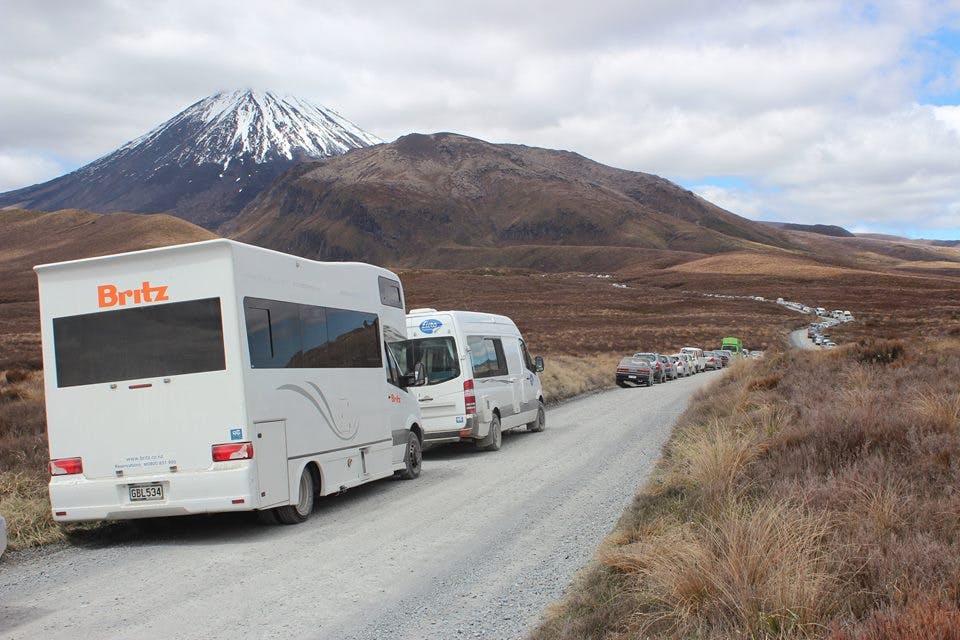Major changes are coming to the Tongariro Alpine Crossing (TAC), as DOC ends all-day parking at the start of the crossing and discourages walkers from climbing the Ngauruhoe and Tongariro summits or swimming in the lakes.
The changes will mean walkers will have to arrange transport to do the crossing, which could allow DOC to manage numbers and reduce bottlenecks.
Parking at the Mangatepopo Road end, where most people start the track, will be restricted to four hours at all times– overstayers will be clamped or towed. Parking at the end of the track, on Ketetahi Road, will also be limited and traffic reduced to one lane.
DOC is promoting return shuttle services as an alternative, which leave from Whakapapa, Ohakune, National Park Village, Taupo and Turangi and can be booked through local iSITEs or through the DOC website. The restrictions will run from Labour Weekend to the end of April.
In a notice sent to tourism operators in the area, DOC asked them to ‘socialise these changes’, and remove any reference to summit trips, images of people swimming in the lakes, or reference to Ngauruhoe as Mt Doom. Climbing Mt Ngauruhoe has become popular with tourists due to the Lord of the Rings trilogy.
Local iwi believe the summits and waters are sacred and have raised concerns that the growing popularity of the track is degrading the area.
Earlier this year, DOC started a strategic review of the crossing, consulting with local iwi Ngāti Hikairo ki Tongariro and other stakeholders.
DOC wouldn’t be drawn on whether the changes created an unofficial cap on the number of walkers on the trail, by limiting the number of people who could access the trail head.
Tongariro operations manager Bhrent Guy says DOC will monitor the shuttle services throughout the season.
The department has recently increased the price for shuttles to operate in the national park. Guy wouldn’t say how much the concession fees has increased, but says “Only a small increase has occurred this season”. He says DOC cannot forecast whether the new regulations will generate more concession income for the department.
Federated Mountain Clubs president Peter Wilson says the restrictions will have a huge impact on the ability of Kiwis to experience the park.
“We’ve been blindsided,” Wilson says.“It’s indicative of a cultural problem in a department that sees itself as the department of tourism.
“This locks Kiwis out. DOC have got to fix it and provide for Kiwis and they have to do it soon.”
Adrift Outdoor Guided Adventures runs guided walks in the National Park and founder Stew Barclay believes the plan will help alleviate crowding on the crossing and reduce the parking problems.
“There is all this talk that the crossing is overcrowded. It’s not, it’s just people have been cramming together at the start and that’s caused bottlenecks,” Barclay says. “With the turnaround time for shuttles travelling from local hubs, start times will be staggered.”
Barclay says Mangatepopo Road has become potholed and there are often up to 500 cars parked along each side of the road.
“There’s barely room for a bus to scrape between them and if two buses meet there’s a big delay.”
He advises against walking from the Ketetahi end to avoid the four-hour parking restrictions.
“There’s a bigger climb, plus the majority of walkers leave from Mangatepopo so you’d be meeting people all the way across.”
The downside, he adds, is that some New Zealanders will say they are used to walking in their parks for free and won’t want to pay for a shuttle. “I’m afraid it’s too late for that here, the horse has left the stable. It’s like sports clubs that have had to change from the amateur to professional level, we’re now in the era of professional management.”
Barclay is also supportive of DOC’s move to discourage summit attempts on Ngauruhoe and Tongariro. Whether from a cultural or safety perspective, a good sensible message is to not climb Ngauruhoe, he says.
“What many walkers don’t realise is that climbing Ngauruhoe is a completely different proposition from walking the TAC. It’s so steep, and loose rocks get kicked down. At least half the Search and Rescue calls each year are now to Ngauruhoe.
“Meanwhile, Tongariro, after all, is the sacred mountain. We guide up there but not to the top, we stop about 10m away. I totally get that.”
Bhrent Guy says he hopes the changes will make the crossing safer.
“By taking a return shuttle, all hikers will be accounted for and this should assist with reducing the number of emergency call outs,” Guy said.
The TAC has become synonymous with issues of overcrowding and tourism. Last season, of the 126,000 people that walked the crossing, 75 per cent were international visitors, with 49 per cent from the UK and Europe, 12 per cent from the US, 5 per cent from Australia, 4 per cent from Canada and 2 per cent from Asia.
Guy says DOC is working with the i-SITEsite and other tourism providers to ensure people are aware of the new regulations.
“For those visitors who do not get the message prior to getting to the hike we will have information flyers given to them detailing the iSITE numbers to book a shuttle, times and distances to the local villages,” he said.
Additional reporting by Kathy Ombler







